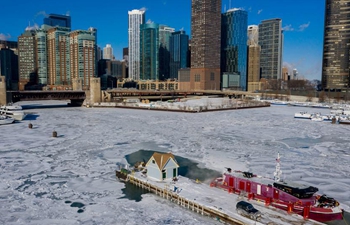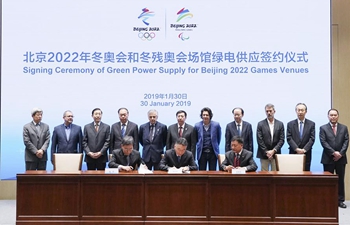BERLIN, Jan. 31 (Xinhua) -- Although the quality of air in German cities slightly improved in 2018, air pollution still remains higher than allowed in at several locations, according to an initial assessment published by the Federal Environment Agency (UBA) on Thursday.
In 30 German cities evaluated, the Europe-wide limit value for harmful nitrogen dioxide (NO2) of 40 micrograms per cubic meter was exceeded last year, UBA said.
"The limit value, which has to be complied with since 2010, is still being exceeded in many German cities. This endangers the health of the people living there," commented Maria Krautzberger, UBA president.
Data from 132 measuring stations in another 35 German cities that failed to meet the air quality standards in 2018 would still require evaluation. UBA expects to announce the final results for all German cities in May 2019.
Stuttgart, home city of Daimler and Porsche, showed the highest level of pollution with 71 micrograms of NO2 per cubic meter of air, ahead of the Bavarian capital Munich.
"The main source is road traffic, especially diesel cars with real emissions that are too high. This is where action must finally be taken," said Krautzberger. These vehicles must be retrofitted with effective catalytic converters -- at the expense of the polluters, namely the automotive industry," UBA President Krautzberger said.
Air quality in Munich, the German city that showed the highest air pollution levels in 2017, has improved significantly. The level of NO2 air pollution has decreased from 78 micrograms per cubic meter to 66 micrograms per cubic meter today.
Back in 2017, a total of 65 German cities exceeded the European limit value for nitrogen dioxide, down from 90 cities in 2016.
NO2 in cities originates to a large extent from diesel exhaust gases. Thus the first diesel driving bans in cities appear to have been justified. In Stuttgart, for example, the ban has been in place since the turn of the year and has been extended to the whole city.
According to UBA, besides the older diesel vehicles, of which millions are still in circulation in Germany, the main sources of air pollution are combustion processes in industry, the energy sector as well as households.
The reasons for the decline in urban NO2 pollution in Germany would be speed limits and traffic restrictions, more new cars, software updates for better exhaust gas purification with older diesel engines, as well as the weather, UBA said.
Shortly before the turn of the year, German Chancellor Angela Merkel announced a budget increase for the country's Clean Air Program, which aims to improve air quality in German cities, from approximately 1 billion euros to 1.5 billion euros (1.72 billion U.S. dollars), and pledged an additional 432 million euros, with which the German government seeks to support the hardware retrofitting of small diesel trucks.













